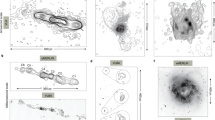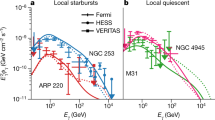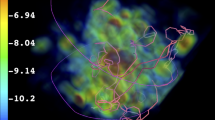Abstract
RADIO-LOUD active galactic nuclei (AGNs) tend to show extended emission in the form of jets and an unresolved central core, from which the jets presumably originate. The intensity spectrum of the core varies smoothly from 108.5 to 1016 Hz in frequency1, and is flat (constant with frequency) between 109 and 1012 Hz, implying that a single emission mechanism, probably synchrotron radiation, is responsible. Because synchrotron emission below ∼10l3Hz would be self-absorbed for a uniform source under conditions typical of AGNs, inhomogeneous models have been used to account for these spectra. These models, which require the magnetic field strength and the electron density and energy to vary according to strict power laws, reproduce the flat spectra by a number of self-absorbed components2–4, but they do not explain the origin of radiating electrons at ∼1018 cm from the AGN core, in view of the very short lifetime of the electrons in an AGN environment. Here we propose that energy is transported from the central source by relativistic neutrons, which travel freely over a large volume and decay into relativistic protons. The protons produce secondary electrons which generate the observed radiation. The photon spectra thus produced are largely model independent and flat.
This is a preview of subscription content, access via your institution
Access options
Subscribe to this journal
Receive 51 print issues and online access
$199.00 per year
only $3.90 per issue
Buy this article
- Purchase on Springer Link
- Instant access to full article PDF
Prices may be subject to local taxes which are calculated during checkout
Similar content being viewed by others
References
Landau, R. et al. Astrophys. J. 308, 78–92 (1986).
Condon, J. J. & Dressel, L. L. Astrophys. Lett. 15, 203–207 (1973).
Marscher, A. P. Astrophys. J. 216, 244–256 (1977).
Band, D. L. & Grindlay, J. E. Astrophys. J. 308, 576–591 (1985).
Kazanas, D. & Ellison, D. C. Nature 319, 380–382 (1986).
Kirk, J. G. & Mastichiadis, A. Astr. Astrophys. 213, 75–79 (1989).
De Kerret, H. et al. Phys. Lett. B63, 477–482 (1976).
Bell, A. R. Mon. Not. R. astr. Soc. 182, 147–156 (1978).
Blandford, R. D. & Ostriker, J. P. Astrophys. J. 221, L29–L32 (1978).
Kazanas, D. & Ellison, D. C. Astrophys. J. 304, 178–187 (1986).
Sikora, M. et al. Astrophys. J. 341, L33–L36 (1989).
Phinney, E. S. in Astrophysics of Active Galaxies and Quasi-Stellar Objects (ed. Miller, I. S.) 453–496 (University Science Books, Mill Valley, 1985).
Kazanas, D. Astrophys. J. 287, 112–115 (1984).
Zdziarski, A. A. & Lamb, D. Q. Astrophys. J. 309, L79–L82 (1985).
Marcher, A. P. Astrophys. J. 334, 552–559 (1988).
Krautter, A., Henriksen, R. N. & Lake, K. Astrophys. J. 269, 81–93 (1983).
Backer, D. C. in Superluminal Radio Sources (eds Zensus, J. A. & Pearson, T. J.) 76–82 (Cambridge University, 1987).
Sikora, M. et al. Astrophys. J. 320, L81–L85 (1987).
Königl, A. Astrophys. J. 243, 700–709 (1981).
Author information
Authors and Affiliations
Rights and permissions
About this article
Cite this article
Giovanoni, P., Kazanas, D. Flat-spectrum radio sources: cosmic conspiracy or relativistic neutrons?. Nature 345, 319–322 (1990). https://doi.org/10.1038/345319a0
Received:
Accepted:
Issue Date:
DOI: https://doi.org/10.1038/345319a0
This article is cited by
-
The luminosity correlation analysis for Fermi blazars
Astrophysics and Space Science (2018)
-
Gamma-ray emission of blazars
Astrophysics and Space Science (1997)
-
Origin of the central radio gaps in extragalactic radio sources
Astrophysics and Space Science (1992)
-
The nature of protons ejected from the nuclei of extragalactic radio sources
Astrophysics and Space Science (1992)
-
Implications of CP violation in hyperon decays
Astrophysics and Space Science (1992)
Comments
By submitting a comment you agree to abide by our Terms and Community Guidelines. If you find something abusive or that does not comply with our terms or guidelines please flag it as inappropriate.



